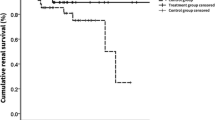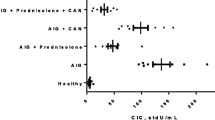Abstract
Objective: To evaluate the relationship between chronic kidney dysfunction after transplantation and chronic vascular rejection (CVR), and to evaluate the efficacy and safety of Tanshinone (Tan) and Herba Lysimachiae (Lys) combined with Mycophenolate Mofetil (MMF) to fight against CVR, and to reduce the incidence of chronic dysfunction in rat renal transplantation model.Methods: Sixty-five male SD rats as donors and sixty-five male Wistar rats as recipients were used. The recipients were divided into five Groups, including Group A: Lys + Cyclosporine A (CsA), Group B: Tan+CsA, Group C: MMF+CsA, Group D: CsA, and Group E: normal saline. Kidney function and morphological changes were assessed at 2, 4, and 6 weeks after transplantation. All sections of renal grafts were stained with monoclonal antibodies (McAB),. including major histocompability complex class II (OX-6), lymphocyte function antigen-1 (CDllb/CD18), intercellular adhesive molecular-1 (IA29), CD8+ (OX-8), and proliferation cell nuclear antigen (PCNA) (5A10, IgGlk) were used. Results:The two control groups developed typical chronic rejection episodes, and the histologic feature indication of kidney chronic rejection includes loss of renal units and presence of an obliteration arteriopathy involving large renal arteries. These were associated with serum levels of BUN and SCr increased and different degrees of glomerulosclerosis. Their mean survival time was lower than that of other groups. By contrast, serum levels of cytokine in control groups was significantly increased when compared with group B and C (P<0.05). Both group B and C had minimum changes in glomeruli and arteries, and expression levels of PCNA on the glomeruli and tubular cells were higher than those of other groups (P<0. 05). However, there was no significant difference (P>0.05) between group B and C.Conclusions: CVR may activate the risk of the factor responsible for the development of graft chronic dysfunction that causes slow, progressive destruction of the transplanted kidney. Tanshinone was extracted from Salvia miltiorrhiza and purified for use in medicine. Especially when Tanshinone combined with a low-dose of CsA, it may fight against the CVR by inhibiting cell infiltration, and improving microcirculation of the graft, and thus the incidence of CVR is reduced. It is suggested that Tanshinone can be applied to treat patients with chronic renal dysfunction when used in combination with a low-dose Cyclosporine.
Similar content being viewed by others
References
Hayry P, Aavik E, Savolainen H. Mechanisms of chronic rejection. Transplantation Proc 1999; 31(7A): 5–8.
Kurokawa T, Takagi H. Mechanism and prevention of ischemia-reperfusion injury. Transplant Proc 1999; 31:1775 -17769.
Jerzy W, Kupiec W. Chronic allograft rejection. Current opinion in Organ Transplantation 1999;4:1 -2.
Faber J, Lime SH, Morris PJ, et al. Renal transplantation in the rat: Details of technique. The Australian and New Zealand J Surgery 1971; 41 (1): 69–75.
Solez RA, Axelsen B, Hallgrimur BK, et al. International standardization of criteria for the histology diagnosis of renal allograft rejection: The Banff working classification of kidney transplant pathology. Kidney Int 1993;44(suppl):411–422.
Sheng H. A method for studies Immunohistochemistry quantification. J Chin Histochemistry and Cellular Chemistry 1995;4(1): 59–61.
Yang XY. Measure the levels of PCNA expression — different methods affects. Chin J Pathol 1993; 22(2): 74–76.
Foggy ML. Chronic rejection-graft arteriosclerosis. Trans- plantation Proc 1990;22(1): 119–122.
Dimness E, Fellstrom B, Larsson E, et al. Can chronic vas- cular rejection of a renal transplant be predicted? Transplant Proc 1995;27(1):881–883.
Fellstrom B, Backman U, Larsson E, et al. Are their markers to initate treatment of chronic rejection? Transplant Proc 1999; 31: 1796–1798.
Briscoe DM, Ganz PT, Stephen I, et al. The problem of chronic rejection: Influence of leukocyte-endothelial interactions. Kidney Int 1997;51(suppl 58):22–27.
Manikkam SA, Morris RE, Strom TB. Immunosuppressants: Cellular and molecular mechanisms of action. Am J Kidney Dis 1996; 28(2): 159–172.
Huang XL, Shen WL, LI YP, et al. Expression of ICAM-1 and LFA-1 molecules in relation to renal allograft rejection in rats. Chin Med Sci J 1999; 14(3): 163–166.
Huang XL, Shen WL, Zhou ZQ. Medicine S inhibits class II MHC expression of intra-graft kidney in rats. J West Chin Univ of Med 1997;28(2):204–208.
Huang XL, Shen XL, LI YP, et al. Chinese drug S and B inhibited expression of ICAM-1 and LFA-1 in renal allografts during rejection. Chin J Nephrology 1998,14(1): 43–46.
Lemstrom KL, Koskinen PT, Hayry PA. Molecular mechanisms of chronic renal allograft rejection. Kidney Int 1995; 48(suppl 52):2–10.
Park SK, Kang MJ, Kon GY. Renal tubule regeneration after ischemic injury is coupled to the up-regulation and activation of cyclins and cyclin dependent kinases. Kidney Int 1997;52:706–714.
Kurokawa T, Takagi H. Mechanism and prevention of ischemia-reperfusion injury. Transplant Proc 1999; 31:1775 -1779.
Gohra HE, Thomas O, Mcdonald EA, et al. Endothelial loss and regeneration in a model of transplant arteriosclerosis. Transplantation 1995; 60(l):96–102.
Jin HM, GU ZL, Wang XH, et al. Clinical application of Salvia preparation and its therapeutical principle of activating blood circulation to remove stasis. Chin Med J 1978; 3:180–185.
CUI H, WANG X, ZHONG ZH, et al. Effect of Salvia to the (methyl-3H) thymidine nucleotide incorporation to cultured hepatocyte in vitro. Pharmacy Bulletin 1987;22(9): 535.
CHEN LZ, ZHOU BL, WU ZQ, et al. Preliminary observation on Salvia in adjusting experimental hepatic microcirculatory disturbance. CJIM 1988;8(3): 161–165.
Forber JS, Orosz CG, Rose ML, et al. Can graft endothelial cells initiate a host antigraft immune response? Transplantation 1996;61(3): 343–349.
Foung RA, Burdman EA, Johnson RJ, et al. Cyclosporine, an induced arteriolopathy in a rat model of chronic cyclosporine nephropathy. Kidney Int 1996;49(3): 1141–1151.
Maria JG, Biol SD, Carla IJ, et al. Cyclosporine enhances leukocyte adhesion to vascular endothelium under physiologic flow conditions. Am J Kidney Dis 1996; 28(1): 23–31.
Johnson HA, Bond VP, A method of labeling tissues with tritiated thymidine in vitro and its use in comparing rates of cellular proliferation duct epithelium of the human breast. Cancer 1961; 14:693–642.
Linden MD, Torres FX, Kubus J, et al. Clinical application of morphologic and immunocyto-chemical assessments of proliferation. Am J Clin Pathol 1992;97(suppl I):S4-S8.
Shankcan SJ. Cell-cycle control and renal disease. Kidney Int 1997:52:294–308.
Author information
Authors and Affiliations
Additional information
This work was supported by the Sciences Foundation of the Ministry of Health Grants (No. C 0103)
Rights and permissions
About this article
Cite this article
Xiaolun, H., Wenlu, S., Guihua, C. et al. Treatment of chronic dysfunction of transplantation kidney in rats —by tanshinone, lysimachiae combined with mycophenolate mofetil or cyclosporine alone. CJIM 6, 208–213 (2000). https://doi.org/10.1007/BF02950930
Issue Date:
DOI: https://doi.org/10.1007/BF02950930




